Forest & Shade Tree – Insect & Disease Conditions for Maine, May 15, 2023
For those of you who don’t receive the paper version of it, the 2022 Forest and Shade Tree Insect and Disease Conditions for Maine report is available now on the Maine Forest Service publications page.
In response to three new satellite infestations detected in March 2023, the Maine Forest Service expanded its emerald ash borer (EAB) emergency order area to prevent the flow of infested ash material into non-infested areas of Maine. New EAB infestations were detected in the towns of Andover and Woodstock in Oxford County and the towns of Corinna and Newport in Penobscot County. The new emergency order area, shaded in yellow, is displayed on the map below. For additional information, please reference the March 31, 2023 Maine Forest Service Emerald Ash Borer Press Release. Rulemaking to amend the quarantine will take place later this year. Opportunities for public comment will be announced in this bulletin.
VOLUNTEERS WANTED: If you reside in the revised emergency order area (shaded in yellow), have abundant small-diameter ash on your property, and are interested in helping the Maine Forest Service monitor for emerald ash borer using a girdled trap tree, please reach out to foresthealth@maine.gov to volunteer. Find out more about girdled trap trees. We are also interested in girdled trap tree network volunteers in areas outside the regulated area to supplement purple prism trap and visual surveillance.
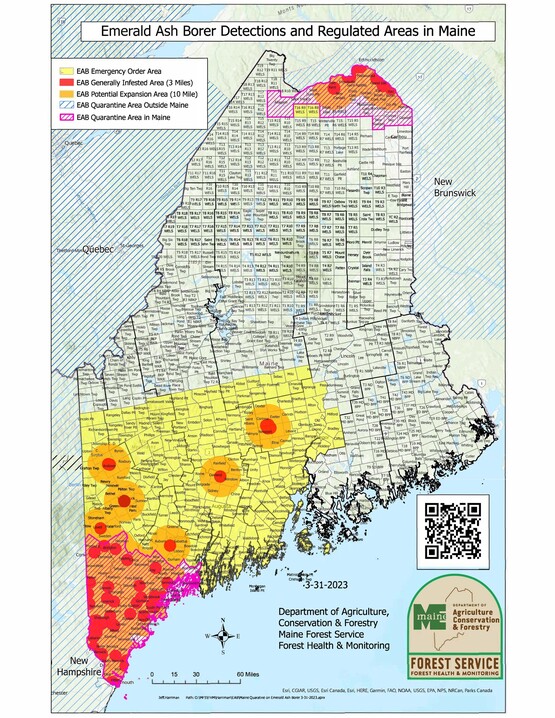 Attention Pesticide Dealers and Applicators – New Rules from the Board of Pesticide Control limiting the use of Neonicotinoid Products
As we gear up for the 2023 treatment season, please be aware of new restrictions affecting the sale and application of noenicitinoid products in outdoor residential landscapes such as lawn, turf, and ornamental vegetation. These include products with the active ingredients dinotefuran, clothianidin, and imidacloprid commonly used in the past against insect pests of ornamental trees. For additional information, please reference the April 5, 2023 Board of Pesticide Control Press Release Announcing Restricted Use Status for Neonicotinoid Pesticides.
Browntail moth (Euproctis chrysorrhoea)
Across Maine where browntail moth (BTM) occurs, we have had emergence of the caterpillars from their long slumber inside their winter webs. We received the first report of emerged caterpillars on Sunday, April 16, which is right on time considering the daytime temperatures and longer days. This year we will continue our network of monitoring sites in order to observe caterpillar development over the season as well as disease outbreaks of the pathogens that infect BTM caterpillars. Many of these monitoring sites have changed location from previous years to best capture trends and developmental differences in the browntail population throughout Maine. The ten monitoring sites for this year are Unity, Dresden, Turner, Brunswick, Belfast, Skowhegan, Garland, Lincoln, Ellsworth, Bangor.
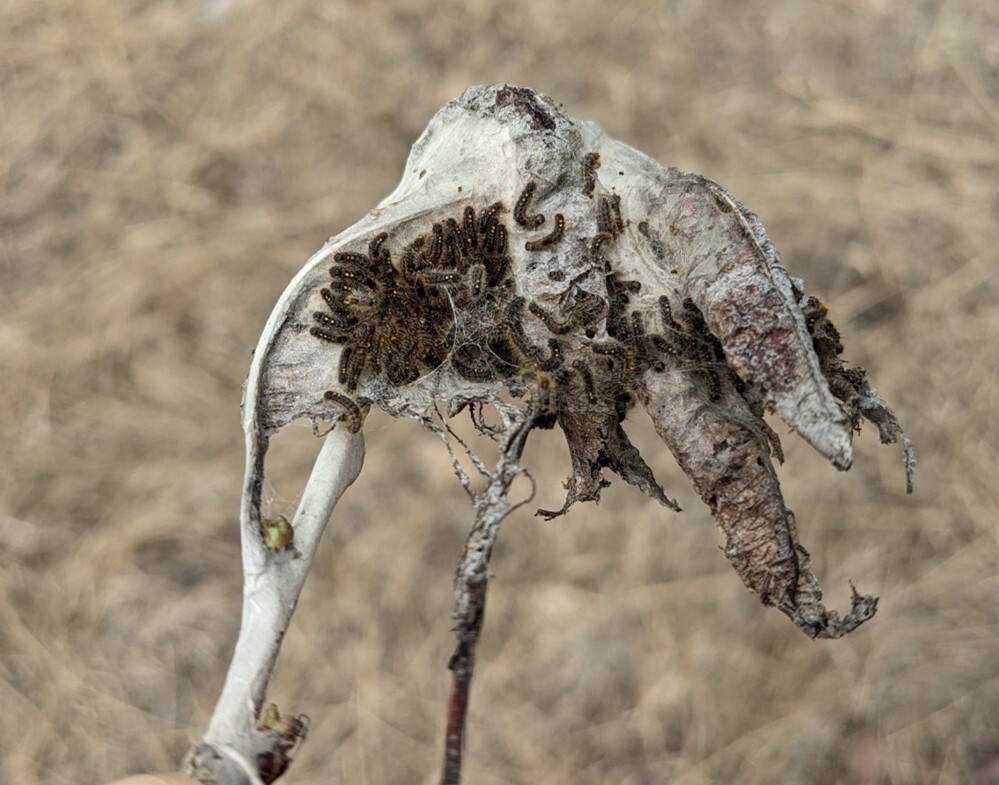 Image: Newly emerged browntail moth caterpillars, Dresden ME.
Based on aerial survey data from last summer/fall, three counties experienced population declines: Kennebec, Cumberland, and Sagadahoc. That said, those areas are not out of the woods yet as browntail populations persist there, just at lower levels. There were also three counties that experienced large population increases: Penobscot, Androscoggin, and Waldo Counties. If environmental conditions this May and June are right with consistent spring rain, disease could lead to further browntail moth population collapses. However, if we have a dry spring going forward, we are likely to see browntail populations spread and fill in areas of previous collapse. People should not count on disease-related collapses to save them from the rash. Please plan ahead for avoiding exposure to hairs and treating symptoms related to exposure.
Where population management has been deemed necessary, plans should be in place. The emergence of the caterpillars marks the end of web clipping efforts. For pesticide treatments like spraying, it is still too early in many locations; however, for some systemic treatments treatment approaches in many areas the time is now. We recommend working with a licensed pesticide applicator for this management approach. In most years, treatments should be effective in killing the caterpillars before the end of May to limit buildup of toxic caterpillar hairs and host foliage loss.
The Browntail Moth Mitigation Fund was established by the legislature and signed into law last year. The fund was established for government entities or non-profit organizations in areas with significant browntail populations to reduce impacts from browntail moth. The rules for this fund have been finalized, and the request for applications (RFA) is open through May 16. Only applications from government entities or non-profit organizations will be considered; funding is not available for individuals. Find more information and look for updates on the Division of Procurement Services Grant RFP/RFA page.
Sign up for our Browntail Moth Updates to stay informed about this insect.
Eastern Tent Caterpillar (Malacosoma americanum) vs Browntail Moth (Euproctis chrysorrhoea)
Around this time of year, we usually receive several calls and emails from concerned citizens who mistake our native eastern tent caterpillar nests for the non-native browntail moth caterpillar nests. Two key differences between these species’ webs are size and position on the tree. The silken nests of native eastern tent caterpillars start small but can grow quite large, reaching around the size of a football, and are attached to the tree where the branches meet the trunk or come together. Additionally, eastern tent caterpillars lack the two characteristic orange spots on their tail end.
Browntail winter webs are the size of your palm or smaller when dormant and are constructed in late summer/early fall on the tips of host species’ branches. The webs are comprised of silk that also incorporates the leaves on the branch tips. As the caterpillars become active in the spring, they travel in and out of the web, and the web can become surrounded in gauzy silk similar in texture to that made by the eastern tent caterpillar. There is a short period of time where browntail webs and eastern tent caterpillar webs can have a similar appearance/size. Browntail moth caterpillars are dark brown and have two orange spots towards the rear of their bodies, which eastern tent caterpillars lack. As the browntail caterpillars molt, they develop white stripes due to white tufts of hair on each segment.
The following photos show the different stages of development in eastern tent caterpillar and browntail moth webs for comparison.
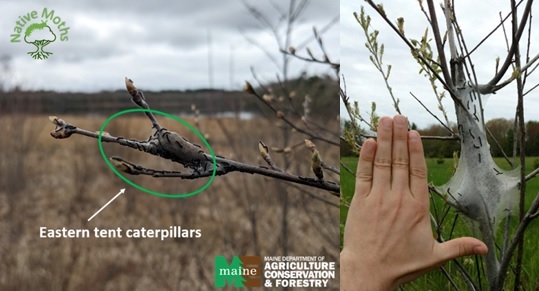 Images: Eastern tent caterpillars upon hatching from their egg mass (left); partially constructed tent near the trunk of the host tree that will become larger as the season progresses (right).
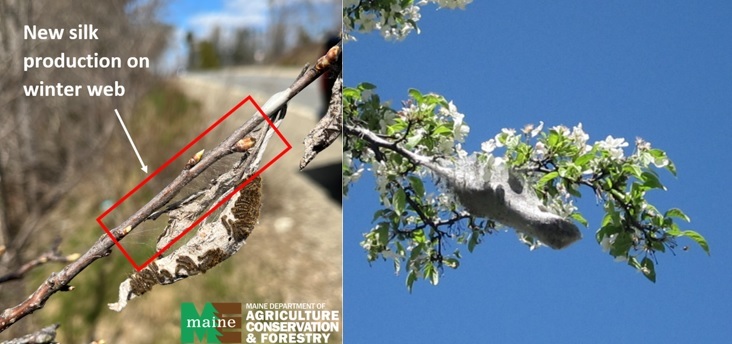 Images: Browntail moth web with emerged caterpillars and new silk production (left); a larger browntail moth web later in the season with the “gauzy” silk (right).
Emerald Ash Borer (Agrilus planipennis)
Retired Portland City Arborist Jeff Tarling provided an update on the emerald ash borer response in the city of Portland, ME, during the Municipal EAB update last week. Tarling had three critical messages for communities with ash in Maine:
1). Develop a plan for the ash in your community
2). Identify trees that will be kept alive with protective insecticide treatments and those that will be removed.
3). Stay connected!
He shared that even though he had gone to many workshops and talks on emerald ash borer, he was still surprised at how quickly the damage developed after the insect became established and that he felt very fortunate they had a plan to help guide the city response as well as inform other members of the community.
Our next planned EAB Municipal Update is in August. Sign up for our EAB Updates to stay informed about this insect.
The most recent detections of emerald ash borer have been in Penobscot County (Newport and Corinna) and Oxford County (Andover and Woodstock). Is emerald ash borer in your woods or the trees in your town? Explore the resources for identification at www.maine.gov/eab and let us know if you think you’ve spotted EAB in a new area.
Since 2019, we have been releasing three tiny parasitoids for potential long-term control of EAB: Tetrastichus planipennisi, Spathius galinae (larval parasitoids), and Oobius agrili (egg parasitoid). In early May, we sampled biocontrol release sites in southern Maine to see if we could find any evidence that they had established. We felled and peeled the bark from young ash trees at each site. We did find a few native parasitic wasps which have learned to parasitize EAB but were not able to detect any of the species released over the past two years. We will continue efforts to detect these parasitoids. We have placed tree segments from each site in rearing barrels and will monitor what emerges. We will be deploying yellow pan traps later in the summer to try to capture adults. New biocontrol release sites will be established this year in Bridgton, Fort Kent, Portland, and Waterville.
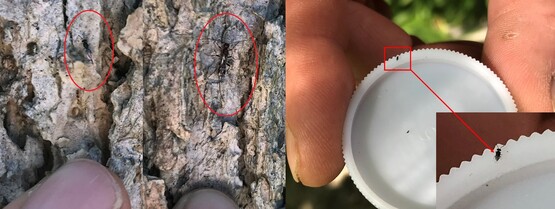 Images: Emerald ash borer parasitoids: Tetrastichus planipennisi (left); Spathius galinae (middle); and Oobius agrili (right). Images: MFS
Exotic Woodborer & Bark Beetle Survey Underway
This month, the Exotic Woodborer and Bark Beetle survey will begin detecting pests that can cause severe damage to Maine's forest resources, economy, and environment. Many of these exotic species could otherwise fly under the radar due to their cryptic damage and resemblance to other insects, so this survey uses targeted traps and chemical lures to draw out any individuals which may be lurking in the environment. This work is partially supported by USDA APHIS through the Plant Protection Act Section 7721 funding.
The program focuses in particular on high-risk industrial sites adjacent to valuable forest resources. In addition to sampling multiple forest types from previous years, the survey now includes four new locations to better detect pests in central Maine. A new species is also being added to the list of targets this year – the beech leaf mining weevil, Orchestes fagi, is a pest of growing concern in nearby Canadian provinces which poses a significant threat to our native beech populations. Overall, this survey is a crucial step in protecting Maine's forests and ensuring their health and vitality for years to come.
Hemlock Woolly Adelgid (Adelges tsugae)
Much of Maine had unusual fluctuations in temperature this past winter. In some areas, the temperatures were close to the freezing mark, and then suddenly dropped into the negative double digits within 12 hours.
The relationship between cold weather and winter mortality of hemlock woolly adelgid (HWA) is not as straightforward as, “at X temperature, Y percent of adelgids die”. There are several things that affect winter mortality rates. One is the timing of the cold. Cold spells in the late winter, when adelgids are starting to become more metabolically active, tend to cause more harm to the insects than early-winter cold snaps. The duration is also important: a longer cold spell will cause more death than a brief cold spell. Also, when the temperature drops suddenly, there tends to be a higher death rate than if it slowly gets colder.
This year, we saw extremely high winter mortality rates at some of our sampling sites, ranging from 98 percent to 100 percent. However, there were some anomalies. In some sites, mortality was much lower – around 60 percent. Overall, the average mortality of HWA was just under 84 percent in the formally quantified sites, lower than we had expected. That might sound like a high mortality rate, but there are two generations of HWA on hemlock trees every year, all of them female and capable of laying eggs without mating. They can lay up to 300 eggs per female. With a mortality rate of 84 percent we expect populations to build (vs. remain stable or decrease) and spread. We are not entirely sure why we saw lower HWA mortality in some sites.
If you are curious about how many HWA survived the winter in your area, you could try something I call the ‘thumb test’. If you see the white, woolly ovisacs on a twig and you aren’t sure if the insects under that waxy ‘wool’ are alive or not, run your finger over the ovisacs. If most of them are alive, you will see many greenish-brown smears on your finger from the insect body fluids. If most are dead, you will see only one or two smears on your finger, and if everything is dry and crumbly, you know all of them are dead.
Watch your hemlock trees this spring and summer. Infested trees in many areas may have a brief respite from HWA due to high HWA winter mortality, but the populations will likely rebound quickly.
And our annual reminder: as of the beginning of March, we are in the high-risk period for spreading HWA. From the beginning of March to the end of July, easily spread eggs and crawlers are likely to be present. If possible, wait until the fall to do major work in your hemlocks.
Winter Moth (Operophtera brumata)
The annual release of Cyzenis albicans flies, the biocontrol agent for winter moth, occurred on May 1 in South Bristol for the second year, in order to boost the population there due to the low number of flies we’ve been able to release there previously. This year we had 447 fly pupae from our caterpillar collection efforts at our previous release sites. Like last year, we had excellent emergence this year with mating flies observed as well. These adult flies will feed on nectar from a variety of different flowers, including red maple, while the females undergo maturation. After the eggs inside the female flies have matured, they will seek out host volatiles from damaged oak and maple leaves among other hosts that winter moth caterpillars have been feeding on. There they will lay eggs on the foliage that will be consumed by winter moth caterpillars. After the caterpillars mature and drop off the tree into the soil, they will spin a cocoon that looks like a small dirt clod that is about the size of a Tic Tac. It is then that the fly larvae inside the parasitized caterpillars become active and consume the caterpillars from the inside. Eventually, the fly larvae will pupate inside the cocoons of the winter moth caterpillars and emerge from the soil the following May.
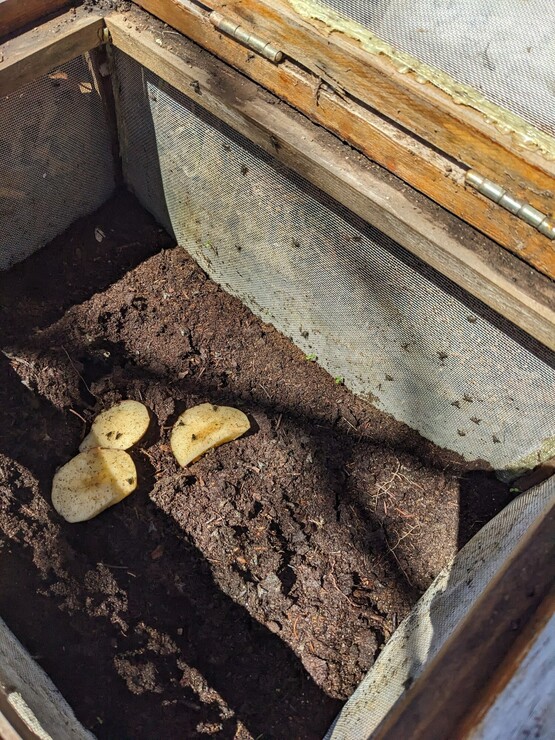 Image: Newly emerged Cyzenis albicans South Bristol, ME.
During the last week of May, we will perform our annual collection of caterpillars from our previous release sites. Flies reared from any parasitized caterpillars collected will serve as the source for next year’s release. In addition, these collections will show where the parasitoid has established successfully and what proportion of the winter moth population is being parasitized.
Beech Leaf Disease (Litylenchus crenatae ssp. mccannii)
Beech leaf disease (BLD) was confirmed in Maine in May of 2021 and has been found since in six counties in the state. While some of these detections were made by Maine Forest Service Forest Health employees and other natural resources staff, many BLD locations were reported by the public, like the readers of this series of monthly reports of forest health conditions. Again this year, we ask readers to keep an eye out for the symptoms of BLD and report any suspicious symptoms you see on trees in Maine’s forests. For a refresher on BLD symptoms, visit the MFS BLD website.
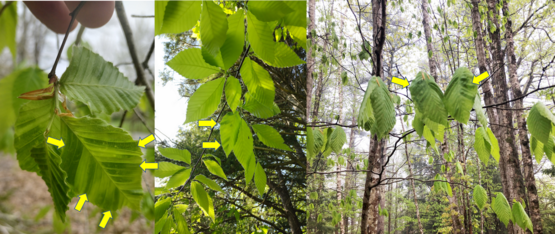 Images: Springtime BLD symptoms showing clear banding symptoms on a young American beech leaf (yellow arrows) (left); A few bands seen via backlighting from the sun (yellow arrows) (middle); Banding and leaf deformation on newly emerged leaves (right). Images: MFS and Karen Coluzzi, Maine Department of Agriculture.
Sooty mold on beech (Scorias spongiosa)
Some of you may have seen accumulations of a sooty, crusty substance on understory beech trees this late fall or winter. This is caused by a specific sooty mold fungus that accumulates in certain areas due to the feeding of aphids, particularly the beech blight aphid (Grylloprociphilus imbricator), although I have also seen this on alder with high populations of wooly alder aphid (Prociphilus tessellatus). As the aphids feed on tree sap, they excrete over 95 percent of what they consume, as they absorb amino acids, which are in short supply in tree sap. Sap has a comparatively high amount of sugars and water, which the aphids excrete. Sooty mold fungus colonizes accumulations of the aphids’ sugary excrement and continues to grow with increasing aphid activity leading to the dark masses and coating on the main stem and branches seen in the pictures below. Very little tree harm is associated with these accumulations and the aphid populations that cause this innocuous symptom typically increase and decrease due to environmental conditions and predation.
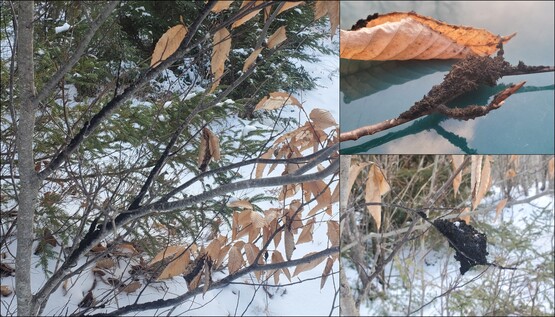 Images: Sooty mold accumulations on a young beech tree. Images Ryan Maker, MFS.
White Pine Blister Rust (Cronartium ribicola)
Early spring is an ideal time to scout your woodlot for currants and gooseberries (plants in the genus Ribes), which serve as a host for the fungus that causes white pine blister rust. Ribes plants are some of the first vegetation to leaf out in early spring and thereby easily located for manual removal or treatment with herbicide. There are several native species in the genus Ribes common throughout Maine. Cultivated and wild varieties of currants and gooseberries are especially efficient alternate hosts for white pine blister rust, which is why it is against Maine state law to bring these plants into Maine and prohibits growing them throughout most of the state – and specifically prohibits growing European black currants throughout the whole state (***see the end of this article for details).
This time of year, it is also possible to scout for the orange pustules that are a sign of the white pine blister rust fungus infecting pine. These structures, called aecia, are typically found on the stem of younger white pine trees and at branch whorls. They indicate the presence of a fungal canker that will eventually girdle the portion of the tree where the fungus grows. These aecia produce the specialized spores (aeciospores) that will infect Ribes leaves. In turn, the infected Ribes leaves will produce a different type of specialized spores that reinfect pine later in summer. As the infection spreads over a few years, branches and stems are girdled and smaller trees can die.
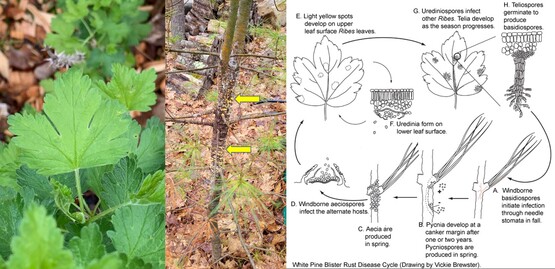 Images: Ribes spp. foliage (Dale Bergdahl) (left); Orange pustules (aecia) erupting from the mainstem of a white pine sapling to spread aeciospores (middle); A depiction of the complex disease cycle of the white pine blister rust disease complex (right) (Vickie Brewster).
Ribes Plant Sales and Planting – Regulatory Reminder
Plants in the genus Ribes (currants, gooseberries, and their hybrids such as “jostaberries”) are an alternate host for the rust fungus that causes white pine blister rust, a devastating disease of white pine. Although regulations surrounding the sale of currants and gooseberries in Maine have been in place for decades, these plants inevitably still show up on nursery shelves each and every spring. Fortunately, DACF also now regularly receives reports when they do, so we are able to take immediate action and prevent these plants from being sold and planted around the state. Already in 2023, we have received reports of Ribes being sold at nurseries in the Midcoast area. If you see any of these plants for sale, please do not purchase, and alert the DACF Horticulture Program. The quarantine regulations can be summarized as follows (for official language, see the Secretary of State Office’s website on rules, 01 669 Chapter 1):
- The sale, transportation, further planting or possession of plants of the genus Ribes (commonly known as currant and gooseberry plants, including cultivated, wild, or ornamental sorts( is prohibited in the following Counties in the State of Maine: all of York, Cumberland, Androscoggin, Kennebec, Sagadahoc, Lincoln, Knox, Waldo, Hancock, and parts of Oxford, Franklin, Somerset, Piscataquis, Penobscot, Aroostook, and Washington.
- The planting or possession of European Black Currant, Ribes nigrum, or its varieties or hybrids anywhere within the boundaries of the State of Maine is prohibited.
More information about WPBR and the quarantine is found on our website. Contact us with questions.
Yellow-Bellied Sapsucker (Sphyrapicus varius)
Sapsuckers are a species of bird that ranges throughout much of North America. They are shy by nature and are often not seen causing damage or are mistaken for another species of woodpecker. They excavate neat rows of holes in the bark, mainly in spring and fall during their migrations, to drink sap and feed on insects attracted to the tree wounds. The holes are larger and much shallower than those typically made by insects, and they are not associated with boring sawdust or frass that are seen with some wood-boring insects. Trees are often able to heal over these shallow holes, but in the meantime, these wounds can represent openings for infection by decay fungi or other pathogens.
Sapsuckers spend winters in southern areas of North America, even ranging into Central and South America. Some migrate through Maine while heading for summer nesting areas further north, many nest in Maine, and in recent years sapsuckers have even been seen overwintering in Maine. There are various creative ways in which people try to deter sapsucker feeding activity, including hanging old reflective compact disks from trees, wrapping parts of trees in burlap or spreading a sticky, glue-like product called Tanglefoot in the damaged area. However, some of these solutions can be problems later on; for instance, if burlap is left on the tree for long periods of time, or the main stem or branches are girdled by twine or wires used to install the burlap. Also, be advised that if you repel sapsuckers from one tree, they will choose their next closest favorite tree, expanding the number of damaged trees. While sapsuckers cause harm and can cause tree stress and even limb dieback, trees are surprisingly resilient to this damage. Thus, employing management should be carefully considered. Sapsuckers are protected by the Migratory Bird Treaty Act.
 Images: Numerous sapsucker holes on a hemlock tree. Despite the high density of the holes, the tree appeared in good health (left); The elusive yellow-bellied sapsucker (middle left), (Johnny N. Dell, Bugwood); Sapsucker holes in a silver maple (middle right); Old sapsucker wounds on a dead birch stem (right).
From the May 1, 1986 Conditions Report:
“Regeneration Problems: Predicted shortages of wood supply have generated a more intensive management approach to natural regeneration and increased outplanting of seedlings to supplement areas with inadequate levels of natural regeneration. We have undertaken a study of problems affecting this resource and will endeavor to address some of the more important ones in more detail.”
May 26, 2023, 8:00 AM - 8:30 AM, Nutting Hall, Orono and Penobscot Experimental Forest, Bradley: Invasive Forest Plant Insect and Pathogen Workshop: Identification and Control Strategies
Join this informative workshop hosted by ME Society of American Foresters member Ron Lemin. The workshop will begin with indoor presentations at Nutting Hall at the University of Maine featuring State Horticulturist Gary Fish, State Entomologist Allison Kanoti, and Ron Lemin. The afternoon will feature four field stops at the Penobscot Experimental Forest in Bradley.
This workshop is approved for the following continuing education credits:
Licensed Forester: 6 hours
Licensed Pesticide Applicator: 6 hours
Fee:
$20.00 MESAF Members
$40.00 Non-Members
Register Online
June 15, 2023, 9:00 AM-11:30 AM (in-person) and 5:30 PM-6:30 PM (virtual), Beauregard Woodlands, Old Town, Maine (in-person) and Zoom (virtual): Forest Health and Pest Workshop with MFS Entomologists
Maine Forest Service Entomologists Gabe LeMay and Brittany Schappach present an educational Forest Health and Pest Workshop hosted by Maine Woodland Owners chapter leader Larry Beauregard. This free workshop will be in two sessions; the first will be a virtual meeting with an introduction and overview of common forest pests and diseases in Maine and how to monitor and reduce damage on your woodlot. The second is an in-person workshop designed to educate landowners on the identification of forest pests and diseases. We invite you to bring any questions or your expertise to walk and talk with us as we learn together. The woodlot has a wide, easy-to-follow trail and features red oak, ash, beech, hemlock, other softwoods and a large pollinator garden. Topics will include ticks, conifer galls, hemlock woolly adelgid, browntail moth, emerald ash borer, white pine weevil, beech leaf disease, and European larch canker. Please review the map guide for instructions on how to get to the woodlot, where to park, and details on the trail we will take. The in-person workshop is an outdoor event in the woods; please dress appropriately for the weather and take precautions to prevent tick bites. Registration is required for both events. If you have any questions, please reach out to Jenn Hicks, jenn@mainewoodlandowners.org, (207) 844-0348. We hope to see you there!
Register for either or both events online
Conditions Report No. 1, 2023
On-line
Department of Agriculture Conservation & Forestry, Maine Forest Service – Forest Health and Monitoring
Contributors: Aaron Bergdahl, Amy Emery, Gabe LeMay, Mike Parisio, Thomas Schmeelk, Brittany Schappach, and Colleen Teerling.
Unless otherwise noted, images by Maine Forest Service, Forest Health and Monitoring, DACF.
|